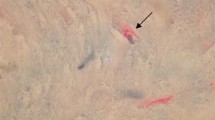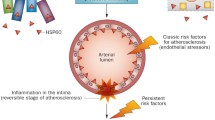Abstract
Heat shock proteins (HSPs) are among the most highly conserved and immunogenic proteins shared by microbial agents and mammals. Human (h) HSP60 is upregulated under stress conditions and serves as a target for cross-reactive cytotoxic HSP-serum-antibodies. The present study evaluates the expressions of hHSP60 and its homologue chlamydial (c) HSP60 in advanced human coronary lesions and correlates intimal tissue-bound HSP expressions with circulating HSP-antibodies. Coronary atherectomy specimens retrieved from 100 primary target lesions of patients with unstable angina (UA; n = 40) or stable angina (SA; n = 60) were assessed immunohistochemically for the presence of hHSP60 and cHSP60. In a subgroup (n = 40), blood samples were tested for anti-Chl. pn.-IgG/IgA-titers and anti-HSP65-antibody titers. Coronary plaques revealed immunoreactive hHSP60 in 55% and cHSP60 in 45% of the lesions. Expression of both HSP homologues was significantly (each p < 0.001) higher in UA lesions compared with SA lesions (7.4 vs. 1.2% and 6.0 vs. 1.1%). HSP homologues showed positive correlations both in UA- and SA-lesions (r = 0.41, 0.33; p < 0.05). cHSP60 showed no association with anti-Chl. pn.-IgG/IgA-titers, whereas expressions of both homologues correlated positive with anti-HSP65-Ab titers (r = 0.42, p < 0.05; r = 0.50, p < 0.01). Intimal amounts of HSP60 homologues were associated with increased expressions of C-reactive protein, Toll-like receptor-4 and tissue factor. Human and chlamydial HSP60 colocalize within coronary atheroma, most prevalent in lesions associated with UA. Our data demonstrate a significant correlation between the intimal expressions of HSP60 homologues and serum HSP65 antibodies, thereby suggesting that humoral immune reactions may play an important role in coronary atherosclerosis and plaque instability.




Similar content being viewed by others
References
Andrié RP, Bauriedel G, Braun P, Höpp HW, Nickenig G, Skowasch D (2009) Increased expression of C-reactive protein and tissue factor in acute coronary syndrome lesions: correlation with serum C-reactive protein, angioscopic findings, and modification by statins. Atherosclerosis 202:135–143. doi:10.1016/j.atherosclerosis.2008.03.028
Andrié RP, Bauriedel G, Tuleta I, Braun P, Nickenig G, Skowasch D (2010) Impact of intimal pathogen burden in acute coronary syndromes—correlation with inflammation, thrombosis, and autoimmunity. Cardiovasc Pathol 19:e205–e210. doi:10.1016/j.carpath.2009.09.009
Balogh S, Kiss I, Csaszar A (2009) Toll-like receptors: link between “danger” ligands and plaque instability. Curr Drug Targets 10:513–518
Bauriedel G, Hutter R, Welsch U, Bach R, Sievert H, Lüderitz B (1999) Role of smooth muscle cell death in advanced coronary primary lesions: implications for plaque instability. Cardiovasc Res 41:480–488. doi:10.1016/S0008-6363(98)00318-6
Benjamin IJ, McMillan DR (1998) Stress (heat shock) proteins molecular chaperones in cardiovascular biology and disease. Circ Res 83:117–132
Biasucci LM, Liuzzo G, Ciervo A, Petrucca A, Piro M, Angiolillo DJ, Crea F, Cassone A, Maseri A (2003) Antibody response to chlamydial heat shock protein 60 is strongly associated with acute coronary syndromes. Circulation 107:3015–3017
Binder CJ, Chang MK, Shaw PX, Miller YI, Hartvigsen K, Dewan A, Witztum JL (2002) Innate and acquired immunity and atherogenesis. Nat Med 9:243–244. doi:10.1038/nm1102-1218
Blasi C (2008) The autoimmune origin of atherosclerosis. Atherosclerosis 201:17–32. doi:10.1016/j.atherosclerosis.2008.05.025
Braunwald E (1998) Unstable angina. A classification. Circulation 80:410–414
Burke AP, Tracy RP, Kolodgie F, Malcom GT, Zieske A, Kutys R, Pestaner J, Smialek J, Virmani R (2002) Elevated C-reactive protein values and atherosclerosis in sudden coronary death. Association with different pathologies. Circulation 105:2019–2023. doi:10.1161/01.CIR.0000015507.29953.38
Ciervo A, Visca P, Petrucca A, Biasucci LM, Maseri A, Cassone A (2002) Antibodies to 60-kilodalton heat shock protein and outer membrane protein 2 of Chlamydia pneumoniae in patients with coronary heart disease. Clin Diagn Lab Immunol 9:66–74. doi:1128/CDLI.9.1.66-74.2002
Danesh J, Whincup P, Walker M, Lennon L, Thomson A, Appleby P, Wong Y, Bernardes-Silva M, Ward M (2000) Chlamydia pneumoniae IgG titres and coronary heart disease: prospective study and meta-analysis. BMJ 321:208–213. doi:10.1136/bmj.321.7255.208
de Graaf R, Kloppenburg G, Kitslaar PJ, Bruggeman CA, Stassen F (2006) Human heat shock protein 60 stimulates vascular smooth muscle cell proliferation through Toll-like receptors 2 and 4. Microbes Infect 8:1859–1865. doi:10.1016/j.micinf.2006.02.024
den Dekker WK, Cheng C, Pasterkamp G, Duckers HJ (2010) Toll like receptor 4 in atherosclerosis and plaque destabilization. Atherosclerosis 209:314–320. doi:10.1016/j.atherosclerosis.2009.09.075
Dieudé M, Gillis MA, Théorêt JF, Thorin E, Lajoie G, Levine JS, Merhi Y, Rauch J (2009) Autoantibodies to heat shock protein 60 promote thrombus formation in a murine model of arterial thrombosis. J Thromb Haemost 7:710–719. doi:10.1111/j.1538-7836.2009.03305.x
Erbel C, Dengler TJ, Wangler S, Lasitschka F, Bea F, Wambsganss N, Hakimi M, Böckler D, Katus HA, Gleissner CA (2011) Expression of IL-17A in human atherosclerotic lesions is associated with increased inflammation and plaque vulnerability. Basic Res Cardiol 106:125–134. doi:10.1007/s00395-010-0135-y
Foteinos G, Afzal AR, Mandal K, Jahangiri M, Xu Q (2005) Anti-heat shock protein 60 autoantibodies induce atherosclerosis in apolipoprotein E-deficient mice via endothelial damage. Circulation 112:1206–1213. doi:10.1161/CIRCULATIONAHA.105.547414
Ghayour-Mobarhan M, Lamb DJ, Tavallaie S, Ferns GA (2007) Relationship between plasma cholesterol, von Willebrand factor concentrations, extent of atherosclerosis and antibody titres to heat shock proteins-60, -65 and -70 in cholesterol-fed rabbits. Int J Exp Pathol 88:249–255. doi:10.1111/j.1365-2613.2007.00542.x
Hansson GK (2005) Inflammation, atherosclerosis, and coronary artery disease. N Engl J Med 352:1685–1695
Higashimori M, Tatro JB, Moore KJ, Mendelsohn ME, Galper JB, Beasley D (2011) Role of Toll-like receptor 4 in intimal foam cell accumulation in apolipoprotein E-deficient mice. Arterioscler Thromb Vasc 31:50–57. doi:10.1161/ATVBAHA.110.210971
Kaufmann SH, Schoel B, van Embden JD, Koga T, Wand-Württenberger A, Munk ME, Steinhoff U (1991) Heat-shock protein 60: implications for pathogenesis of and protection against bacterial infections. Immunol Rev 121:67–90
Kawai T, Akira S (2010) The role of pattern-recognition receptors in innate immunity: update on Toll-like receptors. Nat Immunol 11:373–384. doi:10.1038/ni.1863
Kleinbongard P, Heusch G, Schulz R (2010) TNF alpha in atherosclerosis, myocardial ischemia/reperfusion and heart failure. Pharmacol Ther 127:295–314. doi:10.1016/j.pharmthera.2010.05.002
Kol A, Bourcier T, Lichtman AH, Libby P (1999) Chlamydial and human heat shock protein 60s activate human vascular endothelium, smooth muscle cells, and macrophages. J Clin Invest 103:571–577. doi:10.1172/JCI5310
Kol A, Sukhova GK, Lichtman AH, Libby P (1998) Chlamydial heat shock protein 60 localizes in human atheroma and regulates macrophage tumor necrosis factor-α and matrix metalloproteinase expression. Circulation 98:300–307
Konstandin MH, Aksoy H, Wabnitz GH, Volz C, Erbel C, Kirchgessner H, Giannitsis E, Katus HA, Samstag Y, Dengler TJ (2009) Beta2-integrin activation on T cell subsets is an independent prognostic factor in unstable angina pectoris. Basic Res Cardiol 104:341–351. doi:10.1007/s00395-008-0770-8
Mayr M, Metzler B, Kiechl S, Willeit J, Schett G, Xu Q, Wick G (1999) Endothelial cytotoxicity mediated by serum antibodies to heat shock proteins of Escherichia coli and Chlamydia pneumoniae. Immune reactions to heat shock proteins as a possible link between infection and atherosclerosis. Circulation 99:1560–1566
Mayr M, Kiechl S, Willeit J, Wick G, Xu Q (2000) Infections, immunity, and atherosclerosis: associations of antibodies to Chlamydia pneumoniae, Helicobacter pylori, and cytomegalovirus with immune reactions to heat-shock protein 60 and carotid or femoral atherosclerosis. Circulation 102:833–839
Ohashi K, Burkart V, Flohé S, Kolb H (2000) Cutting edge: heat shock protein 60 is a putative endogenous ligand of the toll-like receptor-4 complex. J Immunol 164:558–561
Rose N, Afanasyeva M (2003) Autoimmunity: busting the atherosclerotic plaque. Nat Med 9:641–642. doi:10.1038/nm0603-641
Schett G, Xu Q, Amberger A, Van der Zee R, Recheis H, Willeit J, Wick G (1995) Autoantibodies against heat shock protein 60 mediate endothelial cytotoxicity. J Clin Invest 96:2569–2577. doi:10.1172/JCI118320
Schulz R, Heusch G (2011) C-reactive protein. Just a biomarker of inflammation or a pathophysiological player in myocardial function and morphology? Hypertension 57:151–153. doi:10.1161/HYPERTENSIONAHA.110.165837
Verma S, Kuliszewski MA, Li SH, Szmitko PE, Zucco L, Wang CH, Badiwala MV, Mickle DA, Weisel RD, Fedak PW, Stewart DJ, Kutryk MJ (2004) C-reactive protein attenuates endothelial progenitor cell survival, differentiation, and function: further evidence of a mechanistic link between C-reactive protein and cardiovascular disease. Circulation 109:2058–2067. doi:10.1161/01.CIR.0000127577.63323.24
Xu Q, Kiechl S, Mayr M, Metzler B, Egger G, Oberhollenzer F, Willeit J, Wick G (1999) Association of serum antibodies to heat-shock protein 65 with carotid atherosclerosis. Clinical significance determined in a follow-up study. Circulation 100:1169–1174
Xu Q, Schett G, Perschinka H, Mayr M, Egger G, Oberhollenzer F, Willeit J, Kiechl S, Wick G (2000) Serum soluble heat shock protein 60 is elevated in subjects with atherosclerosis in a general population. Circulation 102:14–20
Xu Q, Schett G, Seitz CS, Hu Y, Gupta RS, Wick G (1994) Surface staining and cytotoxic activity of heat-shock protein 60 antibody in stressed aortic endothelial cells. Circ Res 75:1078–1085
Zernecke A, Weber C (2005) Inflammatory mediators in atherosclerotic vascular disease. Basic Res Cardiol 100:93–101. doi:10.1007/s00395-005-0511-6
Zhu J, Quyyumi AA, Rott D, Csako G, Wu H, Halcox J, Epstein SE (2001) Antibodies to human heat shock protein 60 are associated with the presence and severity of coronary artery disease. Evidence for an autoimmune component of atherogenesis. Circulation 103:1071–1075
Zimmermann O, Bienek-Ziolkowski M, Wolf B, Vetter M, Baur R, Mailänder V, Hombach V, Torzewski J (2009) Myocardial inflammation and non-ischaemic heart failure: is there a role for C-reactive protein? Basic Res Cardiol 104:591–599. doi:10.1007/s00395-009-0026-2
Conflict of interest
None.
Author information
Authors and Affiliations
Corresponding author
Rights and permissions
About this article
Cite this article
Andrié, R.P., Bauriedel, G., Braun, P. et al. Prevalence of intimal heat shock protein 60 homologues in unstable angina and correlation with anti-heat shock protein antibody titers. Basic Res Cardiol 106, 657–665 (2011). https://doi.org/10.1007/s00395-011-0171-2
Received:
Revised:
Accepted:
Published:
Issue Date:
DOI: https://doi.org/10.1007/s00395-011-0171-2




